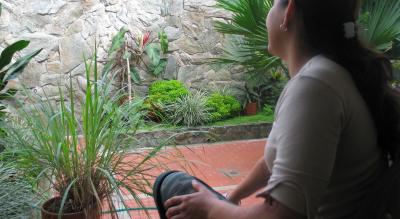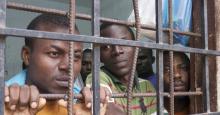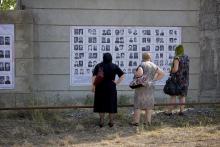Case prepared by Angèle Jeangeorge, Cristina San Juan Serrano and Eva Vaz Nave, LL.M. students at Leiden University under the supervision of Professor Robert Heinsch as well as Sofia Poulopoulou and Christine Tremblay, PhD researchers, Kalshoven-Gieskes Forum, Leiden University; with the contribution of Jemma Arman and Isabelle Gallino, LL.M. students at the Geneva Academy.
A. AGREEMENT ON CHILD SOLDIERS BETWEEN THE COLOMBIAN GOVERNMENT AND THE FARC
Colombia: agreement to reintegrate children from FARC welcomed by UN envoy
16 May 2016 – A United Nations child rights envoy joined the Government of Colombia and the Revolutionary Armed Forces of Colombia (FARC) in Havana, Cuba, yesterday to witness the signing of an agreement to separate and reintegrate children associated with the guerrilla force.
“I feel privileged to be here today with the Colombians and welcome this important commitment, which puts the issue of children at the heart of the peace process and promises to change their lives. This is an urgently needed step for children who have never known a country at peace,” said Leila Zerrougui, the UN Special Representative for Children and Armed Conflict, speaking at the event in Havana, which has been hosting talks between the Colombian Government and FARC since 2012.
Ms. Zerrougui congratulated the parties who led this process, as well as the guarantors and others, in particular the UN Children’s Fund (UNICEF) and the Resident Coordinator’s Office in Colombia, which have supported these negotiations from its onset. […]
As part of the commitment, children under the age of fifteen will be released first, following by the separation of all children under 18. Today’s commitment includes core principles to ensure that separated children will be treated primarily as victims, and that their best interests will be considered as a matter of priority in the reintegration into their communities. […]
According to the UN, hostilities in Colombia between the Government and the FARC have disrupted the lives of more than a quarter of a million children since peace talks began three years ago between the parties to the conflict.
Later in the day, UNICEF also welcomed the agreement by the Colombian Government and FARC, Colombia’s main armed opposition group, for the release of all children under the age of 15 from FARC’s ranks.
“This is a historic moment for the children of Colombia,” said Roberto de Bernardi, UNICEF Representative in Colombia. “UNICEF stands ready to support the release of all children and their reintegration into their families and communities, in accordance with national and international law,” he added.
Peace talks between the Government and FARC to end over five decades of conflict started more than three years ago, leading to significant improvements on the ground: between 2013 and 2015, the number of children killed or injured by landmines and unexploded ordnance halved while the number of displaced children dropped by 40 per cent, according to a recent UNICEF report.
However, the report, Childhood in the Time of War: Will the children of Colombia know peace at last?, also notes that an estimated 1,000 children were used or recruited by non-state armed groups during that period, and over 230,000 children were displaced.[…]
B. THE BEGIN OF DEMOBILIZATION OF CHILD SOLDIERS BY THE FARC
Colombia: FARC begins process of demobilizing minors
Thirteen minors have left the ranks of the guerrilla group as a first step in implementing the agreement reached on 15 May. The International Committee of the Red Cross (ICRC) and the United Nations Children’s Fund (UNICEF) took part in the process; the first eight minors were delivered to them first thing in the morning. “The International Committee of the Red Cross confirms that eight minors were handed over today (Saturday) to a team made up of ICRC representatives and two delegates from civil society organizations,” it announced. The handover was carried out with the utmost discretion to protect their identities. The location was not made public, nor which FARC unit they belonged to. The ICRC said that “discretion was key to the success of this kind of humanitarian operation” and the same approach would be adopted for future handovers of minors.
C. DEMOBILIZATION OF MINORS IN COLLABORATION WITH UNICEF AND THE ICRC
Successful first handover of minors by the FARC in Antioquia
The FARC started handing over the minors in its ranks on Saturday in Antioquia department. The guerrilla group delivered them to the International Committee of the Red Cross (ICRC) in the Carrizal district of Remedios municipality, in the north-east of Antioquia. Saturday’s handover was the first of ten that are due to take place in the coming weeks in various parts of the country.
The minors handed over to the ICRC by the rebel group came from one of the zones in the north-east of Antioquia designated for the FARC to make its transition to civilian life. Jaime Fajardo Landaeta, the peace adviser with the Antioquia government, said that the department was preparing to comply with the agreements on restoring the minors’ rights and to support their reintegration.
The presidential adviser for human rights, Paula Gaviria, said: “Today we can tell the country that the process of minors exiting the FARC is resuming following the final agreement of 24 November.” Ms Gaviria confirmed that the first handover had been a success and would be the first in a series of operations in which minors would be released in the “Zonas Veredales Transitorias de Normalización” (transitional local zones for normalization).
In this part of Antioquia, the FARC has in recent days released lists containing the minors’ details. Before their transfer, the adolescents were assessed by the ICRC medical personnel who were part of the team involved in the operation, to make sure that they were fit to be moved to the reception centre.
“As per the agreement reached by the parties, the minors were received by a UNICEF team at the transitional reception centre,” said Christoph Harnisch, the head of the ICRC delegation in Colombia. “The ICRC will facilitate other similar operations in the coming weeks.”
During the peace talks in Havana, the FARC pledged that all minors under 15 would be released from its camps. In the deal reached between the government and the FARC, a transitional reception plan was set out for demobilizing minors. They would be given a preliminary health check and have their identity determined by the ICRC, before being handed over to a UNICEF reception team.
After the medical assessment, the priority would be to return the children to their families. Until then, they would be temporarily housed by the Colombian Family Welfare Agency and receive psychological support.
“Once the minors arrive at the reception centres, work will get underway with various organizations to restore their rights and subsequently begin the process of family reintegration in the communities where they wish to make a life for themselves,” said the adviser for human rights, Paula Gaviria. […]
“It is not just about getting them released, but also ensuring they get the right care, determining whether they will go home, study or be looked after in a State institution while they adjust,” explained Jaime Fajardo, the regional peace adviser. […]
“This is a sad process, in human terms, because girls and boys will be leaving the camps and leaving behind their hopes, their partners. This farewell is a real blow to the heart and soul of all of them and us who have lived through this together,” said ‘Jairo Quintero’, the commander of the FARC’s Magdalena Medio unit.
The director of the Colombian Reintegration Agency, Joshua Mitrotti, confirmed that there was major work ahead for State institutions to enable these young people to rejoin society and the economy and fully exercise their rights and responsibilities.
In the last 15 years the Colombian Family Welfare Agency has dealt with almost 6,000 children formerly associated with armed groups. Of those, it is calculated that 65% belonged to the FARC.
Discussion
I. Classification of the situation and applicable law
1. How would you classify the situation at the time in Colombia between the government and the FARC? What additional information would you require to make such a determination? Are the parties sufficiently organised for it to amount to a non-international armed conflict? (
GC I-IV, Art. 3;
P II, Art. 1)
2. Has the armed conflict ended? When does a non-international armed conflict end?
II. Obligations of Colombia and the FARC regarding children
3. In addition to the protection granted to the civilian population in general, what special protections are afforded to children in non-international armed conflicts? Does this protection differ from that granted to children in an international armed conflict? Are non-state armed groups such as the FARC obliged to refrain from recruiting them? (
P II, Art. 4(3) and
6(4);
CIHL, Rules 135-
137)
5. The reintegration of former child soldiers in society is at the core of the agreements between the Colombian government and the FARC. Does IHL contain specific provisions on reintegration? Such as provisions that, if complied with, would oblige parties to demobilise and reintegrate former child soldiers? Which ones? How? (
PII, Art 4(3)(a);
CIHL rule 135)
III. Elements contributing to respect for IHL
6. (Document A) What positive effects can the demobilisation of children have in Colombia? For the Colombian peace process as a whole?
7. What might have pushed the FARC to demobilise child soldiers? What influence could organizations such as UNICEF and the ICRC have had in that regard? How will the international community perceive this demobilisation? What about the local population? And you?
8. Document A mentions the public signing ceremony of 15th May 2016. Why was signing the agreement made into such a public event in your opinion? Could this have an impact at the international level? At the local level?
9. What benefits do you see in the involvement of UNICEF and the ICRC in the demobilisation of child soldiers? Looking at Document C, how did their participation help the children in question?






